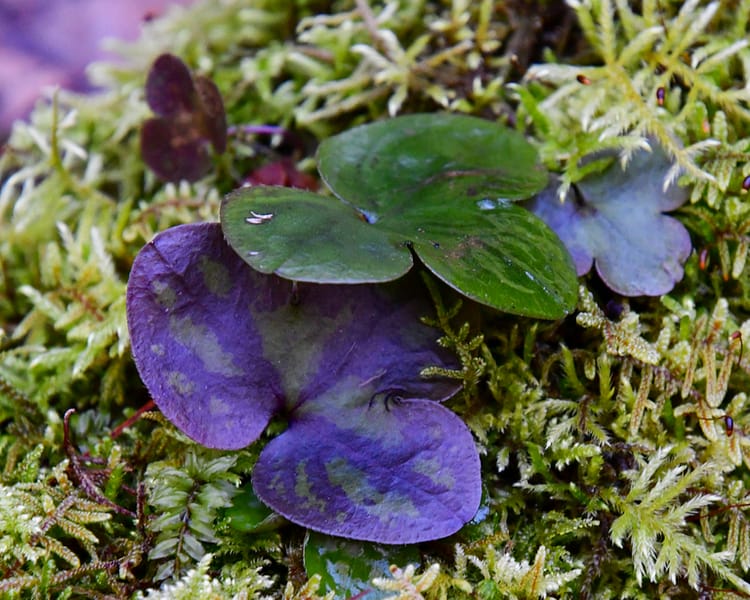Both of these hikes on the Appalachian Trail began at the Nolichucky River, heading north (NOBO) on the AT one week, and two weeks later, south (SOBO). I am always amazed by the difference in plant communities that are found on trails in close proximity to each other. The first week, we did 6 miles to the Curly Maple Shelter; two weeks later we hiked 8.2 miles to from the Nolichucky River to Temple Hill Gap. Both hikes featured some lovely botanical finds. The beginning elevation at the Nolichucky River Gorge is approximately 1800 feet.
Northbound (NOBO) from Nolichucky River to Curly Maple Shelter
I have had to dial back my mileage due to a lingering foot injury, but that gives me plenty of opportunity to enjoy the scenery. Setting out from the NOC (Natahala Outdoor Center), this trail winds through lowland streams, with an abundance of ferns, lichens and other plants that thrive on an abundance of water. It was a freakishly warm day for February. We saw no one else on the trail until we reached the Curly Maple Shelter.
Early harbingers of spring…
One of the early sightings on this hike was Anemone americana, which is a hepatica species that I don’t come across very often. It is an early bloomer, and more common in lower elevations than in the mountains. I really love the purple and green hues on the leaves. https://uswildflowers.com/detail.php?SName=Anemone%20americana

Downy Rattlesnake Plantain is a native orchid, common in the Southern Appalachians and found in many different plant communities. As the name describes, they are covered in downy hair over the entire plant. This time of year, all you can find is the leaves, or perhaps a dried stalk from the previous season. They often grow in large patches via rhizomes, but are just as frequently scattered alongside the trail. Downy Rattlesnake Plantain blooms in midsummer, with tiny white flowers uniformly surrounding the top of a stalk that is typically about a foot tall.

Another favorite is Heart-leaf ginger, with waxy evergreen leaves and cup-like flowers hidden beneath the litter in early spring. The leaf on the right shows the more characteristic variegated pattern surrounding the mid-vein.

Lichen the fungi….
We walked through the cove, interrupted only by the meandering, rushing stream, and surrounded by downed trees draped in mosses, lichens and fungi.

The frilled, concentric patterns of Turkey Tail fungi are stacked atop one another, garnished with bright green moss. This section of the trail was reminiscent of the Pacific Northwest rainforests.

This particular tree is adorned with Eastern Candlewax lichen, interspersed with clumps of eye-popping Orange Jelly fungi!

As we left the streamside cove habitat, the switchbacks started, winding upward to drier ground. I found the Lesser Rattlesnake Plantain, sporting a different leaf pattern and growth habit. The flowers are similar, though smaller and they grow on one side, rather around the entire stalk.

We approached the dry, rocky ridge above the rich cove forest, silhouetted against a spectacular cerulean sky.

We continued upwards, and were soon back in the pine-oak-heat forest and our turnaround point at the Curly Maple Shelter.
South Bound (SOBO) from Nolichucky River to Temple Hill Gap
This section climbs upwards through switchbacks for 3.2 miles, from the Nolichucky River, at 1,700 feet, to Temple Hill, at 3,750 feet. It is very dry, compared to the other side of the trail, but has long range views of the Nolichucky River and Unaka Mountains.

Continuing up the switchbacks, there were mosses carpeting the banks on either side of the dry, rocky trail, beckoning us forward into the mist.

Aren’t these tiny Mealy Pixie Cup lichens cool, reaching up towards the light? Keep in mind that their “cups” are about 2-4mm in diameter!

Along the way, we stopped to admire the views of the Nolichucky. The clouds began clearing out, making way for blue skies.


These fungi were growing on the sides of a rotting trunk; a mature hen of the woods, perhaps? They reminded me of a coral reef.

One of the last finds of the day was this clump of Pelt lichens providing a backdrop and stark contrast to the bright green moss.

Once again, it was another inspiring day on the trail, providing a glimpse into the unique beauty found in each season. Our next hiking journey is “trailblazing” in the snow and ice. I hope you’ll join us!


